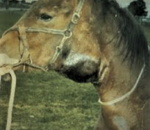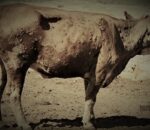Equine influenza is a highly contagious disease of the upper respiratory tract of horses and other equids. The causative agent of Equine influenza is EIV (Equine Influenza Virus) that is an RNA virus. This virus is found endemic to equine populations worldwide. Countries like Iceland, New Zealand, Australia, Japan, and South Africa are currently considered free of Equine influenza.
Equine influenza virus has 2 main forms. Equine-1 subtype (H7N7) & Equine-2 subtype (H3N8). Equine-1 subtype is believed extinct while equine-2 subtype is very important due to its quality of antigenic drift. Equine-2 subtype has different strains which make two lineages, called Florida clade 1 and Florida clade 2. Florida clade 1 is found for many years in the USA, while clade 2 is found in Europe.
Clinical Signs / Symptoms of Equine Influenza
The severity of symptoms of equine influenza depends upon the condition of the animal, its immune status, and age.
- Fever (upto 106F)
- Depression, malaise
- Anorexia
- Muscle pain / weaknesss
- Dry, harsh cough
- Enlarged retropharyngeal lymph nodes
- Serous nasal discharge that becomes mucopurulent with start of secondary bacterial infections
- Sometimes distal limb edema & cardiomyopathy are seen
Transmission /Causes of Equine Influenza
- Horses are infected through inhalation of respiratory droplets after coughing and snorting of diseased horses. Indirect transmission can occur through contaminated equipment, shared water buckets etc.
- Horses having 1-5 years of age are more susceptible to the disease. Racetracks, show grounds, veterinary hospitals etc are most common cause of spread of EIV (Equine Influenza Virus). Equine influenza has a short incubation period (1-3 days).
Diagnosis of Equine Influenza
A tentative diagnosis of equine influenza can be made through observing clinical signs & symptoms. Real-time PCR is performed from nasopharyngeal swabs to detect certain strains of EIV. serological tests are used to confirm the diagnosis of EIV. There are also many stall-side kits (immunoassay) available for diagnosis with varying results.
Treatment of Equine Influenza
Treatment of equine influenza is done by providing rest (quit exercise) and supportive care. NSAIDs (non-steroidal anti-inflammatory) drugs should be used in case of high fever. Antibiotics should be followed when secondary bacterial infections are suspected. One week off should be allowed to horses for their complete recovery.
Control & Biosecurity
Annual vaccination for equine influenza is recommended, but in young horses and horses at increased risk, more frequent vaccination is recommended. In case of an outbreak, a booster dose is recommended in unexposed healthy animals. Booster dose will be valuable if administered at least 10 days prior to virus exposure.
Vaccination reduces the risk of clinical disease. Sometimes, vaccinated horses can also become infected and they exhibit clinical signs. Subclinical shedding of virus is also noted in vaccinated horses.


